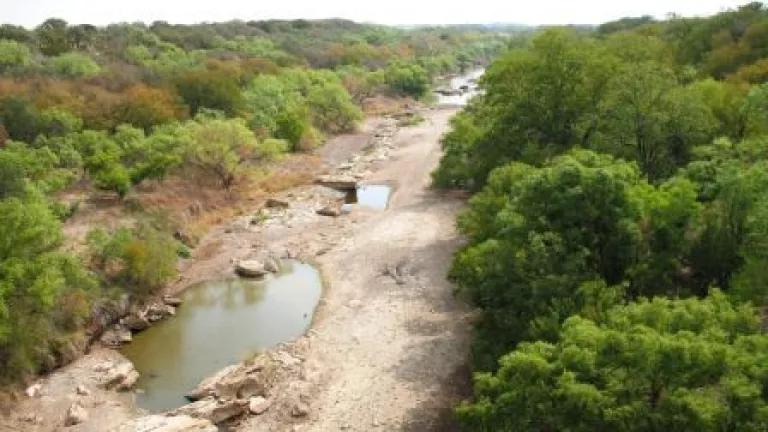
In the last few months, rainfall has provided some much-needed relief from drought conditions that have ravaged Texas over the past year, when the state experienced six of the 10 largest wildfires in Texas history. Even with the welcomed rain, over 80 percent of the state is still either abnormally dry or experiencing drought conditions. While the Texas drought unearthed artifacts at the bottom of lake beds that otherwise likely would not have been found, the repercussions of this historic drought have been overwhelmingly devastating on every level. Dry conditions fueled the wildfire outbreaks last year, which destroyed more than 2,900 homes and 4 million acres and led to the deaths of 10 people. Drought conditions also caused billions of dollars in agricultural losses and completely wiped out farms and businesses, threatened crop and livestock prices, and led to the death of as many as 10 percent of all the trees in the entire state.
Colorado River along Brown and McCulloch Counties, Texas. Photo credit: NOAA
Texas should start planning for repeats of these conditions as hotter temperatures from climate change are likely to drive more extreme droughts.
In a previous post, my colleague, Ben Chou, discussed how the state still uses the 1950s drought as its water supply planning benchmark. Recent research and common sense support the notion that using this dated “drought of record” for planning is unwise. A study published in a recent issue of the Texas Water Journal, which used tree ring records to examine historic drought events before instrumental records began, concludes that while the 1950s drought was severe, there have been longer and more intense drought periods since the 16th century. Furthermore, the authors state that “[i]t would be a questionable strategy for civil authorities to assume that the 1950s drought represents the worst-case scenario to be used for planning purposes in water resources management....” While the past was traditionally assumed by water planners to be a good indicator of the range of climatic conditions to expect in the future, climate change is quickly altering that assumption. If we want to plan effectively, we need to adapt effectively too.
Unfortunately, few state government agencies in Texas, if any at all, appear to be taking climate change seriously. The Texas Water Development Board missed a key opportunity to consider the impact of climate change on water supply and demand in the 2012 State Water Plan. The Plan attempts to downplay the likelihood of climate change by labeling it as an “ambiguous risk” – being “so uncertain that it is not known when [it] will happen, what [its] impacts will be, or even whether [it] will occur at all.” (The Plan also labels terrorism and natural disasters as ambiguous risks.) And even though the Plan acknowledges the possibility of warmer conditions and decreased precipitation because of climate change, the Plan continues to rely on the 1950s drought for planning purposes – preferring to wait and see if a new drought of record occurs before revising current water planning assumptions. Of course, by the time such a drought occurs it may be too late to plan. Just like no one would wait for a terrorist attack or a natural disaster before preparing a response plan, Texas should plan for climate change – which is far more certain than it is ambiguous – now.
With the exception of some activities by the Texas Sea Grant to help coastal communities with sea level rise, not much else is going on at a state-agency level. Texans deserve more and should demand that their state government address climate change risks like many other states are doing.
Today we’re releasing a first-of-its-kind report called Ready or Not: An Evaluation of State Climate and Water Preparedness Planning with an interactive webpage that highlights what all 50 states are doing to address the water-related impacts of climate change. While some states understand their water vulnerabilities and are moving forward aggressively by cutting greenhouse gas pollution and factoring climate change into all relevant state planning and program operations, others like Texas are largely sticking their heads in the sand. If state officials won’t willingly and proactively deal with these threats, then it’s up to the public to compel state leaders to take action.
Want to know what your state is doing to prepare for climate change risks? Find out here. Depending on where you live, you could be pleasantly surprised or very concerned.

